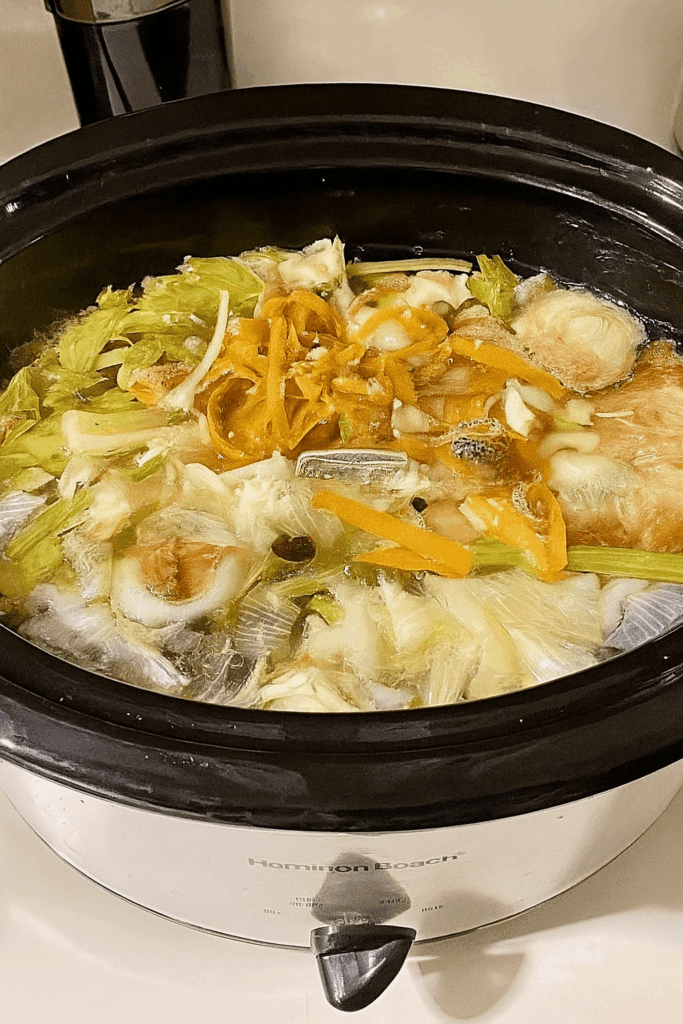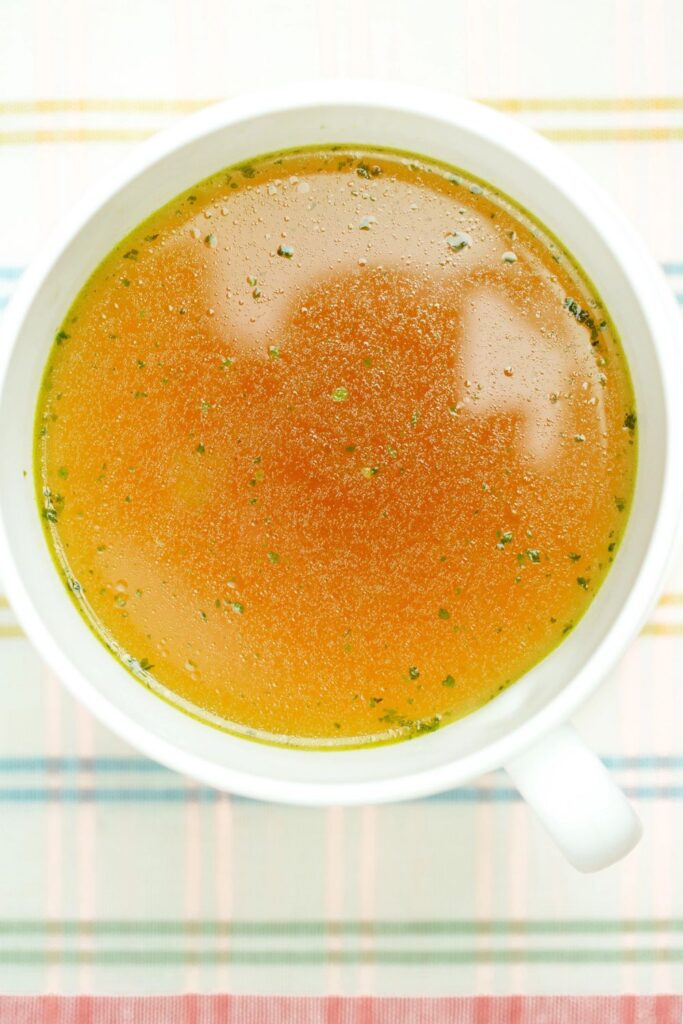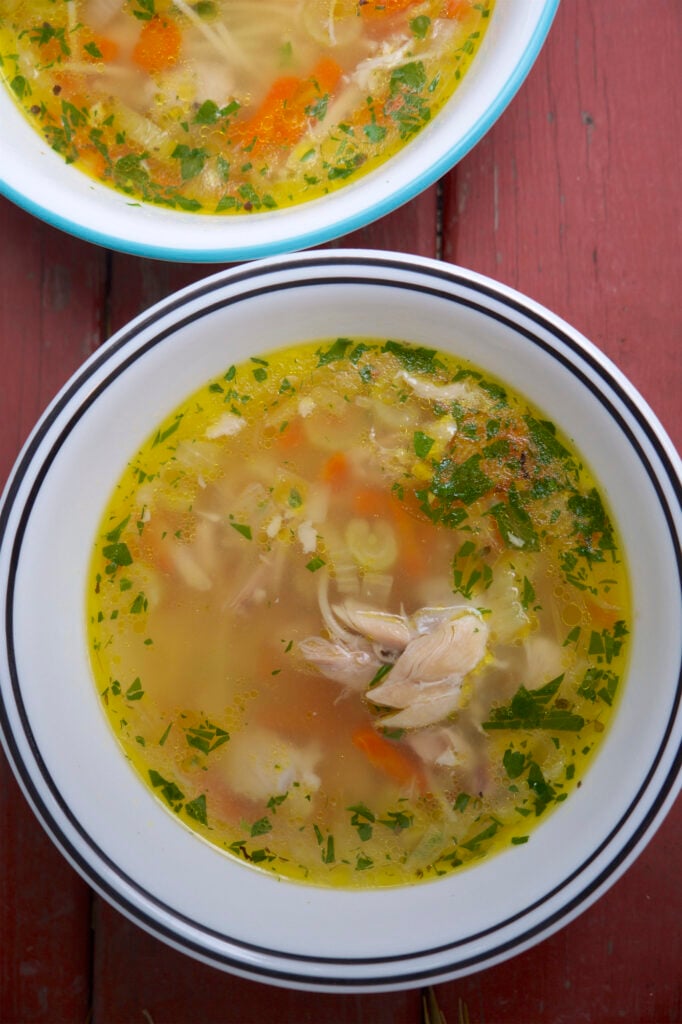If you’ve been throwing away your turkey bones every year, you are missing out on one of the most delicious turkey leftover ideas. Learn how to make broth from a turkey carcass and you will never have to resort to stock in a box ever again!
While time consuming, you don’t have to make stock immediately after Thanksgiving dinner is over. Just toss that turkey carcass into the freezer and pull it out after the holiday chaos has died down.
I don’t have a particular broth recipe that I follow. Frankly, I just have a large plastic zip lock bag in the freezer where I add bones and scraps of vegetables for a few weeks. Once it’s full and I have a few hours to spare at home, I just add the whole thing to my slow cooker. Toss in a few fresh herbs and water and let it simmer all day. Then just cool, strain, and freeze back until the mood strikes for some homemade soup.
Posts feature partner companies & may be sponsored. Post contains affiliate links & I will be compensated if you make a purchase after clicking on links. As an Amazon Associate I earn from qualifying purchases.

Table of Contents
Making Turkey Broth In A Slow Cooker
While I use my slow cooker, you could also use an instant pot or a traditional large stainless steel stock pot on the stove. Once your turkey bone broth is finished make homemade soup. Just add leftover turkey, vegetables, and either rice or pasta depending on your preferences.
I will sum how to make turkey broth from a turkey carcass below if you need specific details on how it’s done. Here’s a detailed, step-by-step recipe for making turkey broth in a slow cooker. Exact ingredient amounts, prep, cook times, and variations are listed as well.
Ingredients
- 1 turkey carcass (from a roasted turkey; about 3–5 pounds of bones, skin, and bits of meat)
- 12 cups (3 quarts) cold water (or enough to cover bones by about 1 inch)
- 2 medium carrots and/or parsnips, roughly chopped
- 2 celery stalks, roughly chopped
- 1 large onion, quartered (no need to peel; the skins add color)
- 4 cloves garlic, smashed (optional)
- 2 bay leaves
- 1 teaspoon whole black peppercorns
- 1 teaspoon salt (you can add more later to taste)
- A few sprigs of fresh herbs. Parsley and/or thyme are my favorites. Substitute dried herbs if that is all you have.
A note on the best vegetables for making broth: I prefer to save vegetable trimmings (carrot tops, celery bottoms, onion skins, etc.) and use those in order to reduce food waste. Check out my post on things to do with food scraps for more tips on reducing food waste in your kitchen.
(Optional: 1 tablespoon apple cider vinegar or lemon juice. This helps extract minerals from the bones.)
Instructions
1. Prepare the bones
- After you are finished removing the turkey meat from your roast turkey, break the turkey carcass into smaller pieces so it fits comfortably in the slow cooker. I find that it is fairly easy to break down by hand but you may want to have a stainless steel meat cleaver on hand to break down larger bones if necessary.
- You can include the skin, neck, and wing tips for extra flavor. I include some of the skin but not all to help balance fat and flavor.
- Remove large globs of fat or stuffing if there are any.
2. Layer the ingredients
- Place the turkey bones in the slow cooker first.
- Add the chopped vegetables and seasonings on top.
- Pour in cold water to cover the bones and vegetables by about an inch (around 12 cups).
3. Cook the broth
- Low heat: 10–12 hours (for a rich, deep broth)
- High heat: 6–7 hours (for a lighter broth)
For the best flavor and collagen extraction, cook on low for the full 12 hours. I have let this go overnight several times with no problems. Make sure you have enough water in your slow cooker and that the lid is on snugly.
4. Strain the turkey broth
- When done, turn off the cooker and let it cool slightly.
- Set a large bowl under a fine-mesh strainer or cheesecloth-lined colander. I recommend fine meshed unbleached cheesecloth.
- Carefully pour the contents through to strain out bones and vegetables.
- Discard the solids.
5. How to store homemade broth
- Let the broth cool to room temperature.
- Skim any fat off the top (optional). Personally I prefer to leave the fat for additional flavor.
- Refrigerate up to 5 days or freeze up to 6 months.
(Ice cube trays work great for small portions.)

✯Don’t want to miss the next post?✯
Follow Turning the Clock Back on Facebook | Twitter | Pinterest
Or join the private Facebook group for simple tips on going green!
Tips And Variations for Turkey Broth
Making homemade broth is a time honored tradition. Over the years, people have come up with quite a few ways to improve the look, flavor, and nutrient profile of it. Here are a few tips that you might want to keep in mind.
- Give it a roasted flavor boost. Roast the bones and vegetables at 400°F (200°C) for 30–40 minutes before putting them in the slow cooker.
- Make gelatin-rich broth. Add chicken feet or a bit of extra cartilage-heavy bone if available.
- Achieve clear broth. Avoid starchy vegetables to ensure a clear turkey stock.
- Try this Instant Pot version. Pressure cook for 2 hours on high, natural release. We have this instant pot if you want to try pressure cooking your stock instead of slow cooking it.
- Vary the herbs. Some herbs are more flavorful than others. Try fresh rosemary or tarragon if you want a unique flavor profile in your broth.
- Use vegetable scraps to save money. Any time you are peeling carrots or trimming celery, just toss those vegetable scraps in a plastic bag in the freezer. When it’s full, add to turkey bones in the slow cooker and simmer with fresh herbs and spices as described above.

What’s The Difference Between Bone Broth And Stock?
Frankly I call bones simmered in water with herbs and vegetables “stock” no matter how it is cooked. Technically, though, there are differences between bone broth and stock.
Bone broth and stock are are both are made by simmering animal bones, meat, and vegetables in water. They differ in cooking time, purpose, and nutritional content.
Stock is typically cooked for a shorter period—about 2 to 4 hours for poultry or up to 6 hours for beef. It is meant to serve as a base for soups, sauces, and gravies. It extracts gelatin from the collagen in bones but doesn’t usually develop a rich, drinkable flavor on its own.
Bone broth is simmered much longer—often 12 to 24 hours. This extracts not only gelatin but also minerals, amino acids, and nutrients from the bones and connective tissues. Often this is aided by the addition of some sort of acid (vinegar or lemon juice, etc.) This longer cooking time gives bone broth a thicker, richer texture. In addition, longer cooking time makes it more nutrient-dense. Because of the rich flavor, it is often drank on its own rather than being made into soup.
Personally, I think the term bone broth is a much more modern concept. Grandma always called it broth so that’s what I call mine, no matter how long it has cooked for.

Ways To Use Homemade Turkey Broth
Once you have your freezer full of turkey stock, there are endless ways to use it in your cooking. It’s a great way to add flavor and nutrients to your recipes. Here are 10 delicious and practical ways to use homemade turkey broth.
- Make Soups and Stews. Use turkey broth as the flavorful base for classic soups like turkey noodle, vegetable, or wild rice soup. It adds depth and richness that store-bought broth can’t match.
- Cook Rice, Quinoa, or Grains. Replace water with turkey broth when cooking rice, quinoa, couscous, or barley for extra flavor and a subtle savory aroma. Check out my post on how to cook with quinoa for more ideas.
- Create Rich Sauces and Gravies. Use it to make homemade gravy, or reduce it into a sauce for meats and vegetables.
- Prepare Risotto. Use hot turkey broth to gradually cook arborio rice for creamy, flavorful risotto without needing extra bouillon.
- Mash Potatoes or Vegetables. Substitute broth for some (or all) of the milk or butter when mashing potatoes, cauliflower, or sweet potatoes for a lighter yet tasty result.
- Braise Meats or Vegetables. Use turkey broth as the braising liquid for tender, juicy roasts or flavorful slow-cooked vegetables.
- Sip It as a Warm Beverage. Enjoy a mug of warmed turkey broth with a pinch of salt, pepper, and herbs—perfect for soothing colds or as a light, nourishing snack.
- Deglaze Pans. After sautéing meat or veggies, pour in a splash of turkey broth to deglaze the pan and create an instant sauce.
- Enhance Stuffing or Casseroles. Moisten bread stuffing, dressing, or savory casseroles with turkey broth to keep them tender and flavorful.
- Boost Flavor in Sauces and Gravies. Add a cup of turkey broth to tomato sauce, chili, or curry to deepen the flavor and balance acidity.
Homemade Turkey Broth From A Turkey Carcass

Ingredients
- 1 turkey carcass (from a roasted turkey; about 3–5 pounds of bones, skin, and bits of meat)
- 12 cups (3 quarts) cold water (or enough to cover bones by about 1 inch)
- 2 medium carrots, roughly chopped
- 2 celery stalks, roughly chopped
- 1 large onion, quartered (no need to peel; the skins add color)
- 4 cloves garlic, smashed (optional)
- 2 bay leaves
- 1 teaspoon whole black peppercorns
- 1 teaspoon salt (you can add more later to taste)
- A few sprigs of fresh herbs. Parsley and/or thyme are my favorites. Substitute dried herbs if that is all you have.
Instructions
Nutrition Information:
Yield:
8Serving Size:
1Amount Per Serving: Calories: 40Total Fat: 1gSaturated Fat: 0gUnsaturated Fat: 1gCholesterol: 16mgSodium: 318mgCarbohydrates: 3gFiber: 1gSugar: 1gProtein: 4g
Nutrition profile may not be accurate
Final Thoughts
Now you know how to turn a turkey carcass into broth (and you see how easy it is!). Making broth can easily be accomplished in a slow cooker, instant pot, or stock pot on the stove. And all you need are a few simple stock ingredients and some patients.
The best part of making turkey broth is the way your house smells while it is simmering! So give this homemade broth a try and skip the boxed (or canned) stuff from the grocery store.

Diane is a professional blogger and nationally certified pharmacy technician at Good Pill Pharmacy. She earned her BS in Microbiology at the University of New Hampshire and has worked in cancer research, academics, and biotechnology. Concern over the growing incidence of human disease and the birth of her children led her to begin living a more natural life. She quickly realized that the information she was learning along the way could be beneficial to many others and started blogging and freelance writing to share this knowledge with others. Learn more about her HERE.
